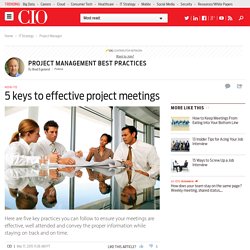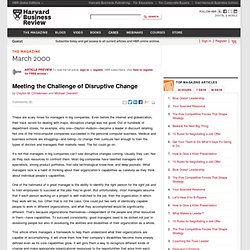

S 10 Must Reads Series Boxed Set (6 Books) This pricing is for PDFs that are purchased and downloaded from our website and printed copies that ship from our warehouse to your requested shipping location. 1-4 = $8.95 each 5-10 = $8.75 each 11-49 = $8.50 each 50-499 = $8.25 each 500+ = $8.00 each Note: Quantity pricing discounts will be reflected at Checkout, prior to submitting your order.

5 keys to effective project meetings. Today we will look at five key practices to adhere to in order to make sure you are never that person running an inefficient meeting.

Sticking to these practices will help make sure you have great meetings that are well attended because you have an awesome reputation for conducting only meaningful and well led meetings that people leave feeling smarter than when they went in. Send out an advance agenda. Do yourself and your attendees a huge favor -- send out an agenda in advance.
It doesn't have to be fully detailed. It doesn't even have to be the final version. Start promptly. Never cancel. End on time. Stay on topic. Meeting best practices These are all logical practices for carrying out good meetings. One more note – while it sounds nice to be the person who brings treats to meetings, don’t do it. The Key to Change Is Middle Management - Behnam Tabrizi. By Behnam Tabrizi | 10:00 AM October 27, 2014 At the inaugural meeting of a change transformation effort under way at a hospital in San Jose, California, nurse Michelle delaCalle faced a room full of people who were discouraged by the organization’s earlier attempts at change.

She stood and shared a story of her own about how making people wait for hours in the emergency department seemed like a violation of her caregiving role. Her story seemed to move people. “I could feel my own intensity,” she said, and when she was done speaking, she could tell that people finally understood the need to change. Change efforts often crumble into excruciatingly dull meetings and PowerPoint presentations. I studied large-scale change and innovation efforts in 56 randomly selected companies in the high-tech, retail, pharmaceutical, banking, automotive, insurance, energy, non-profit, and health care industries. Why many smart people can’t get buy-in from others. I have been thinking about this question for a while and written bits and pieces on the topic before.

Like many other mini-research projects, I embarked on a journey to find out the answer. Here is what I found – some reasons may be obvious but may be not all of them. You be the judge Here are the reasons (in no particular order) [ Note: "You" is used in the article for simplicity and not to imply that you face these issues ] Meeting the Challenge of Disruptive Change. These are scary times for managers in big companies.

Even before the Internet and globalization, their track record for dealing with major, disruptive change was not good. Out of hundreds of department stores, for example, only one—Dayton Hudson—became a leader in discount retailing. Not one of the minicomputer companies succeeded in the personal computer business.
Medical and business schools are struggling—and failing—to change their curricula fast enough to train the types of doctors and managers their markets need. The list could go on. It’s not that managers in big companies can’t see disruptive changes coming. One of the hallmarks of a great manager is the ability to identify the right person for the right job and to train employees to succeed at the jobs they’re given. This article offers managers a framework to help them understand what their organizations are capable of accomplishing.
Where Capabilities Reside Resources. When they ask the question, “What can this company do?” Change Management Is Bigger Than Leadership - Gregory Shea and Cassie Solomon. By Gregory Shea and Cassie Solomon | 12:00 PM March 29, 2013 If an organization needs to undergo significant change, that’s a leadership issue, right?

Old dogs will learn new tricks when the lead dog — or ape, or penguin, depending on the management fable of the moment — shows them off. Leaders need to craft compelling elevator speeches, relentlessly deliver the message of change, and above all, walk the talk. That is all well and good for animal packs, and it helps with humans, too. But by itself, the lead-animal theory is woefully insufficient for changing large organizations or large parts of organizations. How, then, does one lead the changing of an organization, whether it is a company, business unit, service line, department, or work unit? That is just what Hyundai’s Chung Mong-Koo did and the results speak for themselves. This change took time and far more than an inspired “motivational” leader. Watch the Roman Catholic Church.